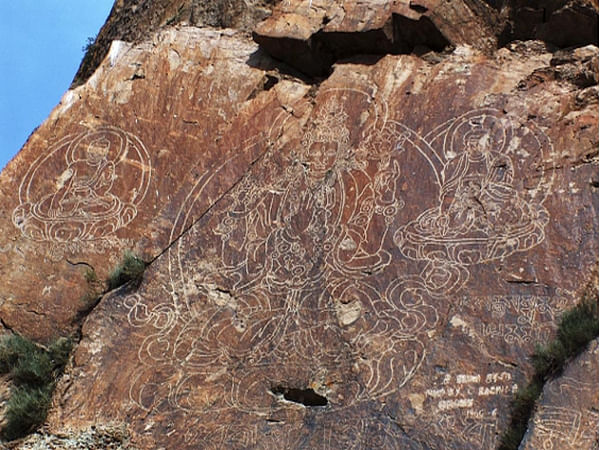By Chandan Kumar
New Delhi [India], May 22 (ANI): In the heart of Central Asia lies a tapestry woven with the threads of history, spirituality, and cultural exchange. Beyond the hustle of the modern world, the ancient remains of Buddhism connect us to a time when caravans traversed the Silk Road, carrying not just goods but also the teachings of the Buddha.
Today, as we uncover the echoes of the past, we find a remarkable tale of interconnectedness between India and the nations of Kazakhstan, Kyrgyzstan, Tajikistan, Turkmenistan, and Uzbekistan.
Kyrgyzstan, nestled in the heart of Central Asia, boasts a rich Buddhist legacy. The city of Osh, a UNESCO World Heritage site, is home to Sulaiman-Too Mountain, where Buddhist monks once meditated. The petroglyphs and archaeological remains in the region bear witness to the flourishing Buddhist presence. The Kyrgyz government, in collaboration with international organizations, is actively engaged in the preservation and promotion of these cultural relics.
Tajikistan, adorned with mountainous landscapes, holds the keys to Buddhist influence in Panjakent. The murals and statues in this ancient town paint a vivid picture of the harmonious coexistence of cultures in the 8th century. In Turkmenistan, the ancient city of Merw opens a window to Buddhist stupas and monasteries, echoing stories of the Silk Road’s rich history.
Uzbekistan, with its enchanting cities like Samarkand and Bukhara, unveils the Fayaz-Tepe Buddhist monastery in Termez–a bridge between India and Central Asia. These remnants, scattered across the region, are not mere relics; they are living testaments to the enduring connections between our cultures.
Kazakhstan, a land of vast landscapes, cradles remnants of Buddhist culture in the Ili River Valley. Taraz, an ancient Silk Road city, whispers stories of the 7th and 8th centuries through statues and stupas.
Last April, 2023, the International Buddhist Confederation organized the first International Conference on Shared Buddhist Heritage of SCO Countries in New Delhi. The occasion was India’s Presidency of the SCO. The international conference marked the revival of India’s millennium-long cultural links with Central Asian countries.
The ties that bind India and Central Asia go beyond religion–they are rooted in the very fabric of our shared heritage. Buddhism, originating in India, embarked on a journey along the Silk Road, leaving an indelible mark on the spiritual landscape of Central Asia. But this connection is not confined to the realm of religion; it extends to art, philosophy, and language.
As we stand at the crossroads of history, it’s imperative to revive and celebrate this millennium-old connection. Governments on both sides have a unique opportunity to rekindle the flames of cultural understanding and cooperation.
Preservation and conservation efforts are the need of the hour. The artifacts and archaeological wonders scattered across Central Asia deserve our attention and care. Initiatives to restore, maintain, and showcase these cultural treasures should be prioritized.
Tourism serves as a vital bridge to revive the shared connection between India and Central Asia. Joint efforts in promoting heritage tourism, collaborative marketing campaigns, and cultural festivals can attract visitors, fostering a deeper appreciation of intertwined history. Education plays a pivotal role in this revival, with a focus on incorporating shared history into curricula. Scholarly exchanges and collaborative research projects enrich academic ties. Cultural exchanges through art exhibitions, music, and film festivals provide living connections to our shared heritage. Diplomatic engagement, emphasizing historical and cultural bonds through high-level visits and collaborations, paves the way for a brighter, more interconnected future.
The Buddhist remains of Central Asia stand as silent witnesses to a millennia-old connection between India and the heart of Asia. These sites are not just relics; they are the threads that weave our stories together. As we navigate the complexities of the modern world, it is crucial to recognize and celebrate this shared heritage. The governments of India and Central Asian countries have a unique opportunity to revive and strengthen these ties, fostering a renewed sense of kinship and cooperation that transcends borders and enriches the cultural tapestry of both regions. By investing in the preservation of Buddhist sites, promoting tourism, supporting educational initiatives, facilitating cultural exchanges, and engaging in diplomatic efforts, India and Central Asia can ensure that the legacy of their ancient connection continues to thrive in the 21st century.
(Chandan Kumar, PhD in Buddhist History, is a young scholar. He is working as an Assistant Professor, Department of History, Satyawati College, University of Delhi). (ANI)
This report is auto-generated from ANI news service. ThePrint holds no responsibility for its content.






